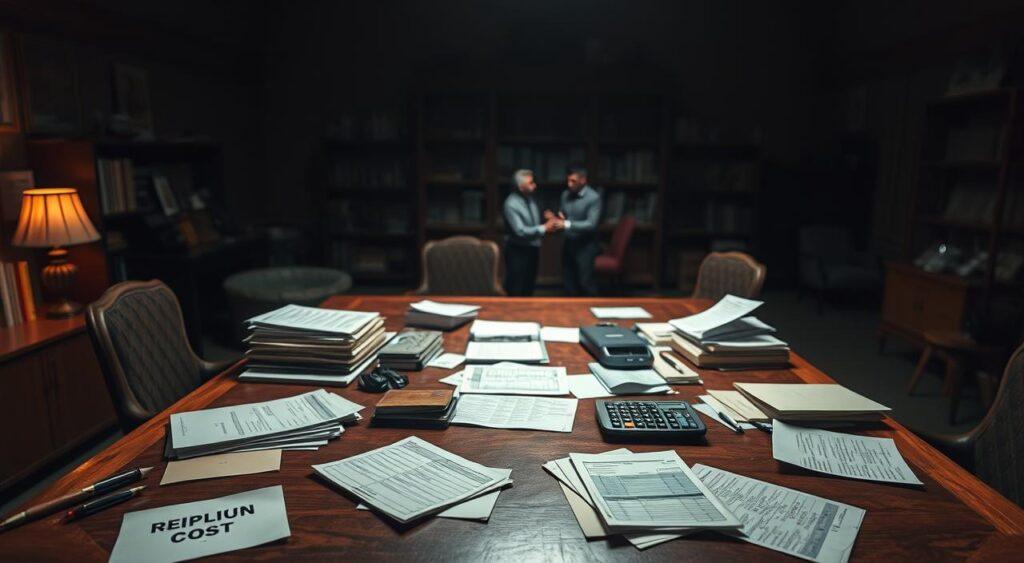Imagine a world where legal rights don’t matter. Could negotiations solve problems? The Coase Theorem changes how we see property, disputes, and fairness. It was created by economist Ronald Coase.
He showed that two parties can solve conflicts over resources without government help—if they can talk freely. It’s like a game where the rules change, but fairness stays.
But what if costs or power imbalances get in the way?
The Coase Theorem says that who holds legal rights doesn’t decide everything. Only the value each party sees in the resource matters1. For example, if a bakery’s noisy mixer bothers a doctor’s office next door, they might make a deal.
The higher-value user keeps the mixer, as long as talks are cheap and honest1. Sounds easy? But real life is different. Over 1,109 studies have tested this idea, showing it doesn’t always work in real life1.
Key Takeaways
- The Coase Theorem shows how bargaining can solve disputes without courts or laws.
- Transaction costs—like negotiation fees or time—often block ideal outcomes1.
- It’s used in law, business, and policy to predict how conflicts might resolve.
- Charlie Munger called it one of the top mental models for smart decision-making Munger’s list.
- It’s a tool to question assumptions about rights, fairness, and efficiency.
Understanding the Basics of the Coase Theorem
The Coase theorem questions if government always needs to step in to solve problems. Think of a rancher and a farmer arguing over cattle damaging crops. The theorem suggests they’ll find a solution that benefits both if there are no transaction costs2.
“The burden of protection, probability of damage, and severity of injury all factor into liability decisions,” emphasized legal frameworks like Judge Learned Hand’s tort formula2.
Definition of the Coase Theorem
Coase’s theory says that when there are no transaction costs, people can bargain to reach the best outcome. For instance, in 2010, Caithness Energy paid $5,000 to neighbors to avoid noise complaints from turbines.
This shows how the theorem works in real life3. But, the theorem’s success depends on:
- No negotiation expenses
- Clear property rights
- Perfect information
- Rational decision-making
Key Assumptions of the Theorem
This creates a perfect world where laws don’t control everything. If rights are clear, like in Denmark’s water rights system, talks can go well2. But in the real world, transaction costs like legal fees or delays can mess things up2.
See how these ideas influence policy in modern environmental disputes.
The Historical Context Behind the Coase Theorem
To understand the Coase Theorem, we must look at the history of economic theory. Ronald Coase’s 1960 paper, “The Problem of Social Cost”4, challenged old ideas about markets and property rights. His work, recognized with the Nobel Prize in 19914, changed how we think about government and resource use.
Ronald Coase and His Contribution
Coase questioned the old views on externalities and transaction costs. His 1960 paper said that clear property rights and low transaction costs can solve problems without government control4.
This idea challenged the status quo, starting debates that last to this day. Over 1,000 economics articles and 2,000 law reviews have explored his ideas5.
Evolution of Economic Thought
Comparative advantage focuses on specialization and trade, but Coase’s model emphasizes negotiation and costs4.
Before Coase, thinkers like David Ricardo discussed comparative advantage. Coase added depth by showing how property rights affect efficiency5. The term “Coase theorem” was coined by George Stigler in 19665.
Old economic theories assumed perfect markets, but Coase revealed how real-world factors like transaction costs can mess with this idea. His work connects classical and modern economic theory, showing that even small costs or unclear rights can change outcomes4.
Real-World Applications of the Coase Theorem
Imagine talking about pollution limits between factories and nearby homes. The Coase Theorem works well when externalities and efficiency
In environmental economics, tradable pollution permits show the theorem’s power. Factories and residents can agree on emissions, balancing costs and benefits. This can mean lowering emissions or paying those affected. But, real-world6 barriers often make it hard to reach these deals6.
For example, water rights in dry areas use Coasean ideas. Farmers and cities trade water shares to be more efficient without strict rules6.
Case Studies in Environmental Economics
- Pollution markets: In the 1990s, U.S. acid rain rules let companies trade emission credits. This cut pollution faster than strict limits7.
- Conservation easements: Landowners and environmental groups make deals to protect habitats. They respect private property rights6.
Implications in Property Rights
Property disputes often involve externalities. For example, tech firms can negotiate patent rights instead of going to court. This can lead to better solutions for everyone. But, high transaction costs can stop these deals, causing problems7.
Courts are starting to use Coasean ideas to decide cases. They look for solutions that make society better, not just follow rules6.
Limitations of the Coase Theorem
The Coase Theorem is a great idea for solving disputes, but it faces real-world challenges. Transaction costs and bargaining issues make it hard to apply in practice.

Transaction costs like legal fees and negotiations can be too high. For example, legal papers alone might cost $1,0008. This makes it hard to find solutions. Even if both sides want to agree, the costs can stop them.
Take a construction project. If the developer’s gain ($700) is less than the neighbors’ loss ($800)8, finding a deal can be tough.
- Search costs: Finding willing partners takes time and money.
- Bargaining costs: Disputes over fair splits of gains or losses.
- Enforcement costs: Ensuring agreements are honored.
“Transaction costs are a common barrier in real-life bargaining situations, often making ideal conditions impossible.”8
When many parties are involved, market failures can happen. Think of a factory polluting several neighborhoods9. Each neighbor’s demands make negotiations complex, leading to no solution9. Power imbalances, like a big company vs. small residents, can also affect negotiations.
The Coase Theorem assumes perfect competition and no transaction costs7. But, these conditions don’t exist in reality. Lawyers often doubt its use because of these issues7. Knowing these limitations helps us see where laws or rules can help when bargaining fails.
The Role of Negotiation in the Coase Theorem
Effectivebargainingis key to the Coase Theorem. With clear property rights, people can find solutions that work for everyone without needing the government10.
Think of two neighbors: one wants to grow their farm, and the other runs a factory nearby. They can talk and find ways to help each other, like changing how they use the land or sharing costs.
“Neighbors could offer money to reduce pollution, achieving a win-win,” Coase’s framework shows this is possible when costs of talking are low11.
- Start by identifying shared goals. For example, a factory cutting emissions might offset costs by charging polluters, while communities gain cleaner air.
- Use data to show mutual benefits. If a study proves reduced asthma cases save healthcare costs, present it to all parties11.
- Build trust by focusing on flexibility. Property rights aren’t final—they’re starting points for creative deals. Would a farmer prefer cash payments or a land swap? Let them choose.
But real-worldproperty rightsnegotiations face challenges. Big companies often have more power, leaving smaller ones out11. High costs, like legal fees or time, can stop fair deals.
When you hit these obstacles, look for mediators or simpler legal rules to make things easier. The theorem teaches us that negotiation is about finding value for both sides, not just winning.
How the Coase Theorem Relates to Modern Economics

Today, modern economic theory and legal analysis use Coase’s ideas to tackle current issues. Policymakers can’t overlook his insights when making rules or dealing with market problems. His work influences policy and studies of human behavior.
Influence on Policy Making
Coase changed how we think about legal analysis in making policies. His 1960 paper, which has been cited over 20,000 times12, shows the importance of balancing property rights and liability rules. For example, environmental policies now consider negotiation costs when setting pollution standards.
Coase’s Nobel lecture pointed out that using prices has limits12. Modern regulations often look at three types of transaction costs: finding prices, negotiating terms, and closing deals12.
- Property rights allocation affects policy outcomes
- Transaction costs shape regulatory choices
- Zero-cost assumptions in economic theory fail in practice
Connection to Behavioral Economics
Traditional legal analysis is a sophisticated form of intuitionistic thought.
Behavioral economics connects Coase’s ideas with human psychology. Cognitive biases like loss aversion can mess up ideal negotiations. Nancy Stokey’s 1981 research13 found that even small costs can change market predictions.
For example, people often overvalue what they own (endowment effect), leading to higher prices than theory suggests. These differences explain why real-world results don’t always match Coase’s zero-cost model.
Keynesian insights also show how group behavior can lead to irrational decisions, making legal analysis more complex.
By mixing economic theory with human behavior, policymakers can make better decisions. Coase’s work shows that understanding transaction costs and human flaws is essential for effective decision-making.
Practical Examples of the Coase Theorem
Imagine two neighbors fighting over a tree’s branches. Or a family arguing about who takes out the trash. The Coase theorem fits these everyday fights. It shows how talking can solve externalities if it’s easy.
For example, a rancher and farmer might agree on a solution for cows damaging crops without going to court14.
But real life is more complex. Let’s see how this works in real situations.
Everyday Scenarios You Can Relate To
- Noisy neighbors: A loud band next door creates noise externalities. You and they might agree on quiet hours or compensation.
- Shared office space: Teams often negotiate who uses a conference room, mirroring how the Coase theorem suggests efficient agreements15.
- Water rights disputes: Farmers and ranchers in arid regions might trade water shares to balance needs.
Comparing Coasean Solutions in Different Contexts
Transaction costs affect outcomes. When neighbors split a yard fence, low costs make bargaining easy. But pollution from a factory? High costs and many affected parties make deals harder14.
Compare a family arguing over chores versus a city negotiating with an oil company. The theorem’s logic works, but real-world barriers like unclear property rights or high negotiation fees often block ideal results.
For instance, flu shot externalities benefit society, but measuring those benefits complicates agreements14.
Urban zoning laws or workplace rules show how context matters. A small team might resolve a desk space clash quickly. But nationwide pollution requires government action because individual bargaining isn’t feasible15.
Conclusion: Embracing the Coase Theorem in Your Mental Model
Using the Coase Theorem changes how you face problems. It turns challenges into chances for efficiency improvements. This approach focuses on finding practical solutions, not just following rules.
It shows how clear property rights and low costs lead to fair agreements without court fights.
Benefits of Understanding Economic Principles
Understanding this theorem helps you find hidden ways to solve disputes. When costs are low, talking things out often works better than going to court, as Coase showed in his studies17. For example, solving noise issues through conversation saves time and money.
This way of thinking helps you make choices that save resources16.
Encouraging Critical Thinking and Strategic Planning
Coase’s work makes you question who really owns a problem. Instead of blaming, you look for the least costly solution16. This way, you ask if a rule is worth its cost. By using legal analysis, you create agreements that work in real life, not just in theory17.
Start noticing when talking could solve problems instead of fighting. You’ll see efficiency grow in your personal and work life.


